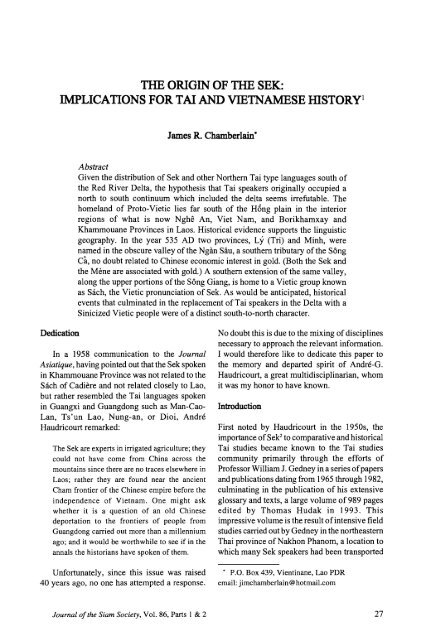The Journal of the Siam Society Vol. LXXXVI, Part 1-2 ... - Khamkoo
The Journal of the Siam Society Vol. LXXXVI, Part 1-2 ... - Khamkoo
The Journal of the Siam Society Vol. LXXXVI, Part 1-2 ... - Khamkoo
You also want an ePaper? Increase the reach of your titles
YUMPU automatically turns print PDFs into web optimized ePapers that Google loves.
THE ORIGIN OF THE SEK:<br />
IMPLICATIONS FOR TAl AND VIETNAMESE IDSTORY 1<br />
James R. Chamberlain•<br />
Abstract<br />
Given <strong>the</strong> distribution <strong>of</strong> Sek and o<strong>the</strong>r Nor<strong>the</strong>rn Tai type languages south <strong>of</strong><br />
<strong>the</strong> Red River Delta, <strong>the</strong> hypo<strong>the</strong>sis that Tai speakers originally occupied a<br />
north to south continuum which included <strong>the</strong> delta seems irrefutable. <strong>The</strong><br />
homeland <strong>of</strong> Proto-Vietic lies far south <strong>of</strong> <strong>the</strong> Hdng plain in <strong>the</strong> interior<br />
regions <strong>of</strong> what is now Nghe An, Viet Nam, and Borikhamxay and<br />
Khammouane Provinces in Laos. Historical evidence supports <strong>the</strong> linguistic<br />
geography. In <strong>the</strong> year 535 AD two provinces, Ly (Tri) and Minh, were<br />
named in <strong>the</strong> obscure valley <strong>of</strong> <strong>the</strong> Ngan Sau, a sou<strong>the</strong>rn tributary <strong>of</strong> <strong>the</strong> Song<br />
Ca, no doubt related to Chinese economic interest in gold. (Both <strong>the</strong> Sek and<br />
<strong>the</strong> Mene are associated with gold.) A sou<strong>the</strong>rn extension <strong>of</strong> <strong>the</strong> same valley,<br />
along <strong>the</strong> upper portions <strong>of</strong><strong>the</strong> Song Giang, is home to a Vietic group known<br />
as Sach, <strong>the</strong> Vietic pronunciation <strong>of</strong> Sek. As would be anticipated, historical<br />
events that culminated in <strong>the</strong> replacement <strong>of</strong> Tai speakers in <strong>the</strong> Delta with a<br />
Sinicized Vietic people were <strong>of</strong> a distinct south-to-north character.<br />
Dedication<br />
In a 1958 communication to <strong>the</strong> <strong>Journal</strong><br />
Asiatique, having pointed out that <strong>the</strong> Sek spoken<br />
in Khammouane Province was not related to <strong>the</strong><br />
Sach <strong>of</strong> Cadiere and not related closely to Lao,<br />
but ra<strong>the</strong>r resembled <strong>the</strong> Tai languages spoken<br />
in Guangxi and Guangdong such as Man-Cao<br />
Lan, Ts'un Lao, Nung-an, or Dioi, Andre<br />
Haudricourt remarked:<br />
<strong>The</strong> Sek are experts in irrigated agriculture; <strong>the</strong>y<br />
could not have come from China across <strong>the</strong><br />
mountains since <strong>the</strong>re are no traces elsewhere in<br />
Laos; ra<strong>the</strong>r <strong>the</strong>y are found near <strong>the</strong> ancient<br />
Cham frontier <strong>of</strong> <strong>the</strong> Chinese empire before <strong>the</strong><br />
independence <strong>of</strong> Vietnam. One might ask<br />
whe<strong>the</strong>r it is a question <strong>of</strong> an old Chinese<br />
deportation to <strong>the</strong> frontiers <strong>of</strong> people from<br />
Guangdong carried out more than a millennium<br />
ago; and it would be worthwhile to see if in <strong>the</strong><br />
annals <strong>the</strong> historians have spoken <strong>of</strong> <strong>the</strong>m.<br />
Unfortunately, since this issue was raised<br />
40 years ago, no one has attempted a response.<br />
No doubt this is due to <strong>the</strong> mixing <strong>of</strong> disciplines<br />
necessary to approach <strong>the</strong> relevant information.<br />
I would <strong>the</strong>refore like to dedicate this paper to<br />
<strong>the</strong> memory and departed spirit <strong>of</strong> Andre-G.<br />
Haudricourt, a great multidisciplinarian, whom<br />
it was my honor to have known.<br />
Introduction<br />
First noted by Haudricourt in <strong>the</strong> 1950s, <strong>the</strong><br />
importance <strong>of</strong>Sek 2 to comparative and historical<br />
Tai studies became known to <strong>the</strong> Tai studies<br />
community primarily through <strong>the</strong> efforts <strong>of</strong><br />
Pr<strong>of</strong>essor William J. Gedney in a series <strong>of</strong> papers<br />
and publications dating from 1965 through 1982,<br />
culminating in <strong>the</strong> publication <strong>of</strong> his extensive<br />
glossary and texts, a large volume <strong>of</strong>989 pages<br />
edited by Thomas Hudak in 1993. This<br />
impressive volume is <strong>the</strong> result <strong>of</strong> intensive field<br />
studies carried out by Gedney in <strong>the</strong> nor<strong>the</strong>astern<br />
Thai province <strong>of</strong>Nakhon Phanom, a location to<br />
which many Sek speakers had been transported<br />
• P.O. Box 439, Vientinane, Lao PDR<br />
email: jimchamberlain@ hotrnail.com<br />
<strong>Journal</strong> <strong>of</strong> <strong>the</strong> <strong>Siam</strong> <strong>Society</strong>, <strong>Vol</strong>. 86, <strong>Part</strong>s 1 & 2<br />
27

















